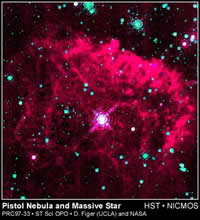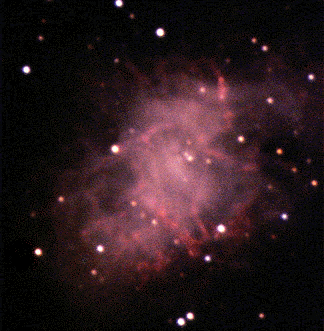The first step of the Hydrogen fusion process: a
nucleus
of Deuterium (2H) is formed from two protons
with the emission of an antielectron and a neutrino.
University of Oregon
The Hydrogen Fusion Process
The basic Hydrogen fusion cycle involves four Hydrogen nuclei (protons)
and two electrons and yields a Helium nucleus, two neutrinos and six photons.
This process occurs in three steps: the first one is the
Fusion
of Hydrogen into Deuterium. Here two protons collide, one proton turns
into a neutron emitting an antielectron and a neutrino.
The remaining proton is bound to the neutron forming a heavy Hydrogen (Deuterium)
nucleus while the antielectron just produced will annihilate with an electron
generating two high-energy photons.
The second step is the the
formation of Helium-3: a proton is captured by a nucleus of Deuterium
emitting a photon and forming then a 3He
nucleus.
The third step is recombination
of two Helium-3 into one nucleus of Helium with the emission of two
protons.
Note that steps 1 and 2 each happen twice for each time step 3 occurs.
In this process the total net energy released is to
26 MeV.
Movies courtesy of University of Oregon
You might also be interested in:

A neutron is a sub-atomic (meaning it is smaller than an atom) particle. The nucleus of an atom is made up of neutrons and protons. Neutrons and protons are almost exactly the same size (a neutron has
...more
Fusion in the core of the stars is achieved when the density and temperature arising from the gravitational pressure are high enough. There are different fusion cycles that occur in different phases of
...more
The basic Hydrogen fusion cycle involves four Hydrogen nuclei (protons) and two electrons and yields a Helium nucleus, two neutrinos and six photons. This process occurs in three steps: the first one is
...more
Neutron capture can occur when a neutron approaches a nucleus close enough for nuclear forces to be effective. The neutron is captured and forms a heavier isotope of the capturing element. When the new
...more
A Supernova is a very massive star that explodes at the end of its life cycle. The supernova is the furnace where the heavy elements (heavier than iron) are formed by neutron capture.
...more
IMF stands for Interplanetary Magnetic Field. It is another name for the Sun's magnetic field. The Sun's magnetic field is enormous and is carried by the solar wind. The solar wind and magnetic field are
...more
Nuclear fusion is a process where two or more nuclei combine to form an element with a higher atomic number (more protons in the nucleus). Fusion is the reverse process of nuclear fission. Fusion of light
...more
The theory of relativity states that no particle can travel at the speed of light in a vacuum. However, light travels at lower speeds in dense media, like water. A particle traveling in water must have
...more














